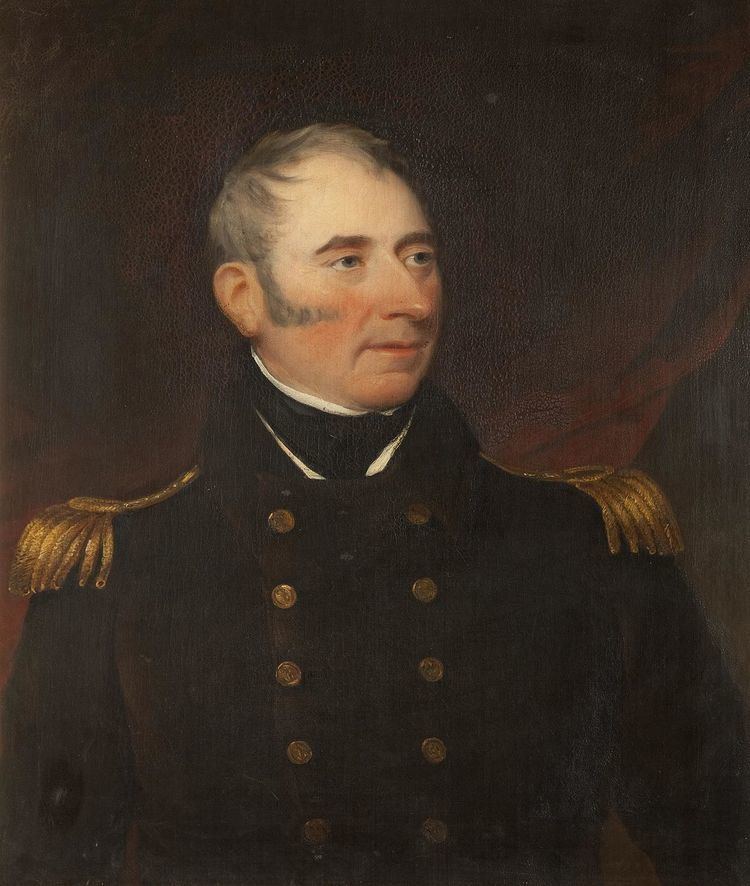Name John Quilliam | ||
 | ||
Died October 10, 1829, Michael Sheading, Isle of Man | ||
John quilliam
Captain John Quilliam RN (born Marown, Isle of Man 29 September 1771 - died Michael, Isle of Man 10 October 1829) was a Royal Navy officer and the First Lieutenant on HMS Victory at the Battle of Trafalgar. He was a farmer’s son from the Isle of Man who was impressed into the Royal Navy in 1794.
Contents
- John quilliam
- Early life
- Career
- Battle of Copenhagen
- Battle of Trafalgar
- Post Trafalgar
- Personal life
- Memorial
- References

Early life
The eldest son of John Quilliam and Christian Clucas of Ballakelly, he was apprenticed to a stonemason, and then worked as a labourer until he was impressed into the Royal Navy.
Career
Unlike most impressed sailors, Quilliam rose rapidly in the Royal Navy. He is first recorded in 1797 at the Battle of Camperdown when he was made a Lieutenant by Admiral Duncan. He was a Third Lieutenant on HMS Ethalion.
On 7 October 1799 Quilliam's share of prize money for the capture of the 36 gun Spanish treasure ship Thetis was over £5000.
Battle of Copenhagen
At the Battle of Copenhagen in 1801 Quilliam was First Lieutenant aboard HMS Amazon. The slight draft of the Amazon meant she was able to get close under the shore batteries, however this in turn led to the Amazon receiving a high volume of damage the result of which was that all the higher-ranking officers were killed leaving Quilliam in command. His gallantry and calmness under fire following the death of Captain Edward Riou and all the senior officers on his ship was rewarded with being made First Lieutenant on HMS Victory by Horatio Nelson.
Battle of Trafalgar
Quilliam became an accomplished officer during his time as First Lieutenant on the Victory and assisted in steering her into action at Trafalgar. A contemporary report stated:
"Just as she (the Victory) had got about 500 yards of the larboard beam of the Bucentaure the Victory's mizzen-topmast was shot away, about two-thirds up. A shot also struck and knocked to pieces the wheel; and the ship was obliged to be steered from the gun room, the First Lieutenant John Quilliam and master Thomas Atkinson, relieving each other at the duty."
Post Trafalgar
After Trafalgar he was promoted to Captain and placed in command of HMS Ildefonso, a Spanish 74 having to refit her at Gibraltar and not arriving in England until May 16, 1806. In 1808, he was captain of Admiral Stopford's flagship, HMS Spencer. In 1812, he was captain of HMS Crescent on the Newfoundland Station and served as such until the defeat of Napoleon in 1815. On September 18, 1813 off Cape Row as Captain of the Crescent, Quilliam captured the 14 gun American privateer schooner the Elbridge Gerry together with her crew of 66 men.
Personal life
Although still an active naval officer, in 1807 Capt. Quilliam was invited to become a Member of the House of Keys. At that time the body was self elected, the members being chosen by the Lieutenant Governor on the recommendation of the house.
Following his career in the navy, Captain Quilliam returned to the Isle of Man, investing his considerable wealth in numerous properties and continuing his career in politics as a Member of the House of Keys. He was again invited to continue as a Member of the House of Keys in 1817, and on December 21 of that year he married Margaret Stevenson at Castletown. The marriage produced no children.
In 1826 Capt. Quilliam was instrumental along with Sir William Hillary in the formation on the Isle of Man of a District Association of the Royal National Institution of the Preservation of Life from Shipwreck. He also served as Chairman of the Committee for Shipwrecked Seamen.
Capt. Qulliam died on October 10, 1829. He was buried in the Stevenson family vault in the graveyard at Kirk Arbory.
Memorial
There is the following inscription on his tombstone;
"Sacred to the memory of John Quilliam, Esq., Captain in the Royal Navy. In his early service he was appointed by Adml. Lord Duncan to act as lieutenant at the Battle of Camperdown; after the victory was achieved, this appointment was confirmed. His gallantry and professional skill at the Battle of Copenhagen attracted the notice of Lord Nelson, who subsequently sought for his services on board his own ship, and as his lordship's first lieut. he steered the Victory into action at the Battle of Trafalgar. By the example of Duncan and Nelson he learned to conquer. By his own merit he rose to command: above all this he was an honest man, the noblest work of God. After many years of honourable and distinguished professional service, he retired to this land of his affectionate solicitude and birth, where in his public station as a member of the House of Keys, and in private life, he was in arduous times the uncompromising defender of the rights and privileges of his countrymen, and the zealous and able supporter of every measure tending to promote the welfare and the best interests of his country. He departed this life on 10 October 1829 in the 59th year of his age. This monument is erected by Margaret C. Quilliam to the memory of her beloved husband."
